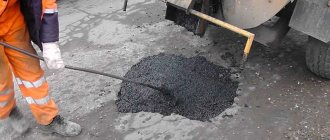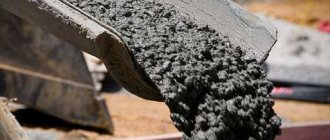Laying asphalt is the most cost-effective method of creating a road surface, and at the same time, it is quite difficult. Asphalt paving technology requires adherence to a specific algorithm of sequential actions, as well as the accuracy of their implementation. The main part of the work when paving from scratch is occupied by preparing the base. The cushion, in turn, plays a major role in the stability and durability of the asphalt concrete road surface.
It is no secret that there are quite a lot of unscrupulous contractors who, in order to save on materials, equipment and work time, do not comply with the asphalt laying technology in accordance with GOST and, thus, the asphalt begins to crumble and sag after the first winter.
Asphalt laying technology according to GOST
Laying asphalt according to state standards requires the following compliance:
- Bitumen consumption rate
. To prime the asphalt base, bitumen emulsion is used with a consumption of 0.4 l/m2 for an asphalt base and 0.8 l/m2 for a base of concrete, crushed stone and asphalt chips.
- Coating thickness
. The minimum thickness of asphalt when paving the top layer of blind areas and sidewalks is 3 cm; when paving the roadway, the top layer must be at least 5 cm.
- Temperature
. At the time of laying, the asphalt temperature must be at least 120°, and the air temperature at least +5°.
- Coating Density
. The asphalt surface must be properly compacted. The compaction coefficient of asphalt type B is not less than 0.98, type A and B is not less than 0.99.
- Asphalt smoothness
. When measuring the evenness of asphalt with a three-meter rod, 95% of the clearance values should not exceed 3 mm, the remaining 5% of the clearance values should not exceed 6 mm.
In addition to the above points, asphalt laying technology also involves asphalt paving in dry weather without precipitation, in order to avoid laying asphalt on a damp, unprepared base. Let's consider the basic asphalt laying technologies, which are most often used in asphalt paving from scratch and asphalt repair.
Types and composition of asphalt
There are two types of asphalt used to cover roads: cold and hot. The composition of any type will be the same, the difference lies in the percentage of components.
The components of asphalt are:
- sand;
- crushed stone;
- bitumen;
- mineral powder.
The federal standard adds a 10 cm layer of concrete, the layers of sand and crushed stone increase - 50 and 40 cm, respectively.
The percentage of components depends on the road for which purpose the coating will be laid.
GOST 11-10-75 recommends using the cold laying method for repairing main roads, in courtyard areas, and for constructing sidewalks.
Hot paving of asphalt is a method by which a new road surface is formed by compacting the mixture before it hardens.
Percentage composition of components
The percentage of all components of the asphalt mixture and the compaction coefficient are given by SNiP 3.06.03-85.
If asphalt is laid on a highway surface, then the percentage of crushed stone that can withstand short-term loads of up to several tens of tons will be large. When laying paths and driveways for passenger cars, crushed stone is either not used at all or is replaced with fine gravel.
The bitumen content (a refined petroleum product) can range from 1% (minor roads) to 11% (major highways). Bitumen is used to provide shock absorption to the road surface, increase tire adhesion to the road, and eliminate slipping.
Mineral powder is obtained by crushing limestone and fossilized remains. The structure of the powder is viscous and contains a lot of carbon, which helps relieve internal stress. It is most often used when laying asphalt pavements on bridges and highways; it is practically not used on secondary roads.
The last component of the asphalt mixture is sand. It is carefully cleaned of impurities to increase the strength of the final mass.
Asphalt impregnations
Asphalt laying technology involves the use of impregnations that improve the quality of the road surface.
Today GOST 11-10-75 recommends several types of impregnations.
Acrylic polymer based mass. It is very expensive, can be installed in small areas (tennis courts, special areas, etc.), has high quality protection, and is produced in several colors.
Coal tar. It is not subject to destruction from the ingress of petroleum products, lasts a long time, has a high-quality structure and color.
Asphalt emulsion. A common and affordable coating, short-lived, requiring constant repair.
To extend the service life when laying, SNiP 3.06.03-85 recommends using mesh under asphalt. They increase the density of the fabric and ensure its adhesion. The same characteristics are achieved by high-quality compaction of the asphalt concrete mixture, for which an asphalt roller is used.
Protective impregnations and coatings for asphalt - materials and equipment
Hot styling method
Hot paving of asphalt is common, less expensive and produces good results. SNiP recommends heating the finished mixture to 130ºС; at the time of filling the roadway, the temperature should be at least 100 ºС.
Hot asphalt can be laid manually. The step-by-step process is as follows:
- Preparing the concrete mixer. For this purpose, use a metal barrel in which holes are drilled in the bottom and top center using an electric drill (16 mm drill). A strong axle is inserted into them and scalded in a circle. Sturdy handles for scrolling are attached to the sides. The entire structure is installed on a support.
- Bookmark ingredients. Crushed stone and mineral powder are placed in a barrel and mixed. For bitumen, take another vessel, the mass is heated until homogeneous. Heated bitumen is added to a barrel containing a mineral-crushed stone composition. The barrel must be turned all the time. After adding a sufficient amount of resin (10%), sand is poured in and the resulting composition is mixed well.
- Rolling up. Place hot asphalt on the prepared area about 5 cm thick and compact it tightly with a hand roller. When in contact with the mass, the tool must be moistened with water to ensure a smooth surface.
If the asphalt is laid efficiently, it can withstand a weight of up to 5 tons without deteriorating from water and sun.
Cold styling method
These works are carried out using a ready-made mixture, which can be bought in the store. It will eliminate the laboriousness of preparing a hot mixture. But such a mass is expensive, and coatings made from it do not withstand high summer temperatures.
GOST 11-10-75 prohibits this method of paving on main roads and provides for the use of cold asphalt only for road repairs or in summer cottages.
This method is performed in stages:
- Preparatory stage. Purchasing a ready-made mixture in a store. On future paths, a layer of earth (10 cm) is removed, half of the depression is filled with crushed stone and compacted.
- Layer-by-layer laying of asphalt mixture. Two layers are laid at intervals of 20 minutes, each carefully compacted with a hand roller. The thickness of the laid layer is 2-3 cm.
- Final works. At the last stage, the canvas is compacted again and sprayed with water. You can use it within a day.
Cold asphalt laying technology
Laying asphalt this way will take a little time because the mixture is already ready. It will take several hours to lay the path, but the hole can be closed in 5 minutes.
Technology for laying asphalt from scratch
To create a road surface from scratch, you need to adhere to the following algorithm of actions:
- Excavation
. Depending on the design level of the road surface, it is necessary to excavate the soil to the thickness of the entire pie (crushed stone + sand + asphalt). Typically the thickness of the notch is around 60 cm.
- Laying sand
. It must be laid with layer-by-layer tamping, 20-40 cm thick.
- Installation of curbs
. After laying the sand, you can begin installing road and garden side stones.
- Laying crushed stone
. It is also laid in layers, using different fractions of crushed stone from larger to smaller, with a thickness of 10-30cm.
- Bitumen spill
. The bitumen emulsion is poured onto crushed stone using a asphalt distributor at a flow rate of 0.8 liters per m2.
- Laying asphalt
. At the final stage, the asphalt itself is laid. Usually this is a two-layer coating with a total thickness of 10 cm.
After the asphalt laying work, if necessary, markings are applied, signs are installed, etc.
If it's minus outside the window
At sub-zero temperatures, asphalt is laid using cold mixtures. This is a polymer asphalt obtained thanks to additives, due to which it is plastic and frost-resistant. Adhering to technology, the use of the composition requires the addition of bitumen thickeners. There are two types of cold mixtures used: fine-grained and sandy, fractions - 5 mm and 10-15 mm.
In extreme weather conditions it is very important to obtain a durable coating and this technology allows you to achieve this. The cost of the work is high, but cold modified mixtures are increasingly being used due to the ability to carry out work in snow and rain, as well as temperatures of + 60 °C.
Scope of technology application:
- coatings located next to the rails;
- spot repairs of highways and routes;
- access roads, parking lot coverage;
- preventive measures during road repair work;
- formation of a blind area in other cases.
Before work, the surface should be cleaned of excess moisture, snow and debris. Additionally, temperature control mechanisms are required.
Technology of laying asphalt on old asphalt
This technology is used when it is possible to raise the level of the current asphalt concrete surface by at least 5 cm. Therefore, it is necessary to take into account all heights and junctions with other coatings. To apply the technology of laying asphalt on old asphalt, you need to adhere to the following algorithm of actions:
- Cleaning the base from dirt and dust;
- Dismantling of junctions with a width of 1 meter;
- Raising well necks to a new design level;
- Leveling layer of asphalt concrete chips or fine crushed stone;
- Spill of bitumen emulsion;
- Laying asphalt with a thickness of at least 5 cm.
This technology is very popular due to the fact that it is one of the most cost-effective methods of asphalt repair, since we avoid complete dismantling of the coating.
How to organize the installation process step by step
Repairing a hole using cold asphalt consists of several stages:
- Cleaning the pit from large debris
- Aligning edges
- Cleaning from asphalt residues, small debris and dust
- Backfilling with crushed stone (optional)
- Impregnation of walls and edges with bitumen (optional)
- Backfilling asphalt
- Tamping
All this in cross section looks something like this:
We once again draw your attention to the fact that two of the seven stages are optional (filling with crushed stone and impregnating the edges with bitumen). They are needed to fill a hole whose depth is more than 20 cm.
So that you have the most general idea of how to carry out pothole repairs with cold asphalt yourself, below we will analyze all the stages in detail.
Step 1 – cleaning the pit from large debris
First of all, it is necessary to clear the pit of large stones and debris. It may contain pieces of old asphalt and crushed stone from the base. It is best to remove them with a regular shovel. After this, you will be able to understand how to cut and level the edges, measure the depth of the pothole.
Step 2 – Aligning the Edges
You can skip this step if you have a small pothole that can be easily filled with cold asphalt alone. But for better stability of the repaired area, you need to cut the edges of the hole at an angle of 90°. This can be done using a hand grinder or a road saw. The old coating must be cut off in such a way that an area of more or less regular geometric shape is obtained.
Step 3 – cleaning of small debris and dust
After leveling the edges, all debris and pieces of old asphalt are again removed from the pit. Then the bottom is cleaned of small particles and dust. Finally, dust removal can be done with water. To do this, you need to moisten the edges of the pit. Don’t worry that there will be liquid left at the bottom in this case. It will in no way interfere with the further progress of work.
Step 4 - filling with crushed stone
If the depth of the hole exceeds 20 cm, its bottom can be half filled with crushed stone. The stone pad adheres well to the asphalt and allows you to halve the amount of cold asphalt used. In addition, the stones will provide strength and prevent subsidence of the asphalt road surface.
Step 5 – impregnation with bitumen
To make the patch on the road durable, it is better to impregnate the bottom and walls of the hole with bitumen. When filling the bottom with crushed stone, the top layer of the pillow is treated. It is best to have a sprayer on hand that will evenly distribute the material over the entire surface. If you don't have it, you can use a regular bottle.
For normal impregnation you will need 300-500 ml of bitumen or emulsion per 1 m2 of area. For a small pit with an area of 0.5 m2, you will spend no more than 100-200 ml of binder.
Step 6 - backfilling asphalt
If work is carried out in the cold season, the asphalt must be preheated in a warm room or using a heater to 15-25°C. If you previously stored the material in bags, be sure to knead the bag before use so that the asphalt becomes mobile. After this, you can pour it onto the prepared surface.
The asphalt must be evenly distributed over the entire area and leveled. This can be done with your hands (if the hole is small) or with any other device (beam, shovel, garden hoe). You need to pour asphalt with a margin of 1 cm for every 5 cm in height. This is done so that after compaction and compaction the material does not sag.
The thickness of the asphalt layer should be no more than 5 cm. If this is not enough, the mixture is laid in two layers, tamping each one in turn.
The amount of material is calculated depending on the thickness of the coating.
Examples of calculating the volume of cold asphalt per 1 m3:
- For a layer of 50 mm – 0.05 cubic meters
- For a layer of 100 mm – 0.1 cubic
- For a layer of 1,000 mm – 1 cubic
If you plan to buy cold asphalt in bags, you need to be able to convert the volume into kg. To do this, you need to know the bulk density of the material. For cold asphalt this figure is 2300 kg/m3.
Therefore, to fill 1 m3, you will need:
- For a 50 mm layer: 0.05×2300=115 kg of cold asphalt
- For a layer of 100 mm: 0.1×2300=230 kg of cold asphalt
For more accurate calculations of the amount of material needed for your area, use our Calculator. To convert cubes to tons, use a bulk density of cold asphalt of 2,300 kg/m3.
Step 7 - tamping
Like hot asphalt, cold asphalt also needs to be thoroughly compacted.
You can do this in several ways:
- Manual tamper
- Vibrating plate
- Wheels of a car
The method depends on the size of the hole and your capabilities.
Manual tamping is suitable for small holes whose area does not exceed 0.5 m2. If the volume of work is larger, it is better to use a vibrating plate. In the absence of any specialized device, you can compact cold asphalt using a car, driving the wheels over the surface several times.
Compaction should be carried out in a spiral, from the edge to the center of the pit. It is necessary to walk over the surface at least 10 times to ensure that the asphalt is compacted. Also note that after compaction is completed, the layer of fresh cold asphalt should be 0.5 cm higher than the base surface. During use, for example, under car tires, it will shrink further and eventually level out with the old coating.
At the end, it is recommended to sprinkle the asphalt with sand. This is necessary to reduce the stickiness of the coating so that there are no marks left on it from car wheels, bicycles or shoes.
You can use the repaired coating as soon as the work is completed.
Cold asphalt laying technology
Cold asphalt is used for minor asphalt repairs. Unlike hot asphalt, it is sold in bags, and the laying technology is very simple. The technology for laying cold asphalt is as follows:
- Cleaning the base from dust and dirt;
- Laying and leveling asphalt;
- Rolling the coating with a vibrating plate.
Also, the main advantage of laying cold asphalt is the permissible air temperature of up to -25°. Therefore, this technology is often used in winter.
Maintenance of asphalt concrete pavement
If you want the finished road surface to have a long service life and not have to re-concrete everything, you will have to follow some maintenance recommendations.
Heavy equipment or cars cannot be driven on the new asphalt. It is strictly forbidden to drive tracked vehicles on it. Due to its properties, this coating is too soft for such vehicles, and the tracks will leave damage on the surface. In the future, these dents will provoke destruction and the asphalt will have to be repaired or re-asphalted.
This prohibition is especially relevant at high ambient temperatures. This happens due to the fact that in hot weather the asphalt softens even more and is much more susceptible to the negative effects of technology. If defects, cracks or other damage are found on the surface, they should be repaired as quickly as possible in order to prevent further destruction of the road surface.
Winter asphalt laying technology
Until recently, asphalt laying in winter could only be done with cast and cold asphalt. However, modern technologies for the production of materials make it possible today to expand the temperature range at which asphalt can be laid.
Previously, according to the law, it was possible to lay asphalt only at temperatures above +5°C. Today, it is possible to carry out asphalt laying work at fairly low temperatures (up to -10°C), as well as in conditions of moderate precipitation. Winter asphalt laying technology allows asphalt to be laid only on existing concrete or asphalt. The base must first be thoroughly cleared of ice and snow. It is not allowed to lay asphalt on crushed stone in winter.
The main reasons for poor road quality
Important!
Failure to comply with the regulatory requirements of SNiP and GOST when carrying out repair work leads to poor condition of roads.
There are a number of main reasons for the deteriorated state of roads:
- when carrying out paving work during rain, water gets into the asphalt layers, which leads to the appearance of holes;
- savings on the emulsion mixture;
- the layer is laid of inadequate quality, which is why the crushed stone does not adhere properly to the old asphalt;
- replacing crushed stone with crushed brick, which leads to subsidence and collapse of the road surface;
- the use of asphalt of inappropriate quality and laying of insufficient thickness provoke the appearance of cracks and destruction.
We cannot exclude the fact of human negligence during the work, non-compliance with laying technologies in rain and snow.
Materials for asphalt mixture
The asphalt mixture for hot laying is created at an asphalt concrete plant according to GOST standards, which precisely indicate the percentage of all components.
- Coarse aggregates, crushed stone and gravel from dense rocks are cuboid in shape. Grain size 10-40 mm.
- Fine aggregate – sand. Use quarry sand or crushed stone screenings. Fine aggregate increases the density of the mixture, increases the strength of the road surface and the ability to withstand high temperatures.
- Mineral powder affects the properties of the binder component. Too much powder may reduce the strength of the coating.
- The binding component bitumen can be liquid or viscous. The required viscosity coefficient is indicated in regulatory documents.
Based on their composition, asphalt concrete mixtures are divided into coarse-grained, fine-grained, and sandy.











